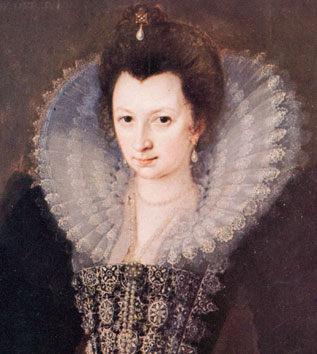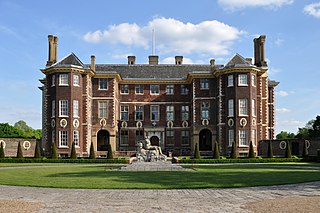
Edward de Vere, 17th Earl of Oxford, was an English peer and courtier of the Elizabethan era. Oxford was heir to the second oldest earldom in the kingdom, a court favourite for a time, a sought-after patron of the arts, and noted by his contemporaries as a lyric poet and court playwright, but his volatile temperament precluded him from attaining any courtly or governmental responsibility and contributed to the dissipation of his estate.

John Bourchier, 2nd Baron Berners was an English soldier, statesman and translator.

Thomas Knyvet, 1st Baron Knyvet was an English courtier and Member of Parliament who played a part in foiling the Gunpowder Plot.

Marcus Gheeraerts was a Flemish artist working at the Tudor court, described as "the most important artist of quality to work in England in large-scale between Eworth and van Dyck" He was brought to England as a child by his father Marcus Gheeraerts the Elder, also a painter. He became a fashionable portraitist in the last decade of the reign of Elizabeth I under the patronage of her champion and pageant-master Sir Henry Lee. He introduced a new aesthetic in English court painting that captured the essence of a sitter through close observation. He became a favorite portraitist of James I's queen Anne of Denmark, but fell out of fashion in the late 1610s.

Elizabeth Hastings, later Countess of Worcester was a noblewoman born in Scotland to Francis Hastings, 2nd Earl of Huntingdon, and Catherine Pole. On 16 December 1571 at Whitehall Palace in a triple wedding with Edward de Vere, 17th Earl of Oxford and bride, Anne Cecil, and Edward Sutton, 4th Baron Dudley and bride, Mary Howard, she married Sir Edward Somerset, 4th Earl of Worcester, son of Sir William Somerset, 3rd Earl of Worcester and Christian North.
Bridget Norris, Countess of Berkshire was an English noblewoman, the daughter of Edward de Vere, 17th Earl of Oxford. Bridget was brought up by her maternal grandfather, the powerful statesman William Cecil, 1st Baron Burghley. She was also styled Lady Norris of Rycote and Viscountess Thame. She married Francis Norris, 1st Earl of Berkshire; however, the marriage was not a success, and they separated in 1606.

Elizabeth Stanley, Countess of Derby, Lord of Mann, was an English noblewoman and courtier. She was the eldest daughter of the Elizabethan courtier and poet Edward de Vere, 17th Earl of Oxford.

Anne de Vere, Countess of Oxford was the daughter of the statesman William Cecil, 1st Baron Burghley, chief adviser to Queen Elizabeth I of England, and the translator Mildred Cooke. In 1571 she became the first wife of Edward de Vere, 17th Earl of Oxford. She served as a Maid of Honour to Queen Elizabeth before her marriage.

Susan Herbert, Countess of Montgomery, was an English court office holder. She served as lady-in-waiting to the queen consort of England and Scotland, Anne of Denmark. She was the youngest daughter of Elizabethan courtier, and poet Edward de Vere, 17th Earl of Oxford.
Elizabeth de Vere, Countess of Oxford, formerly Elizabeth Trentham, was the second wife of the Elizabethan courtier and poet Edward de Vere, 17th Earl of Oxford.

Henry Berkeley, 7th Baron Berkeley, KB was an English peer and politician. He was Lord Lieutenant and Vice-Admiral of Gloucestershire. He was the grandfather of George Berkeley, 8th Baron Berkeley.
Sir William Knyvett was an English knight in the late Middle Ages. He was the son of John Knyvett and Alice Lynne, the grandson of Sir John Knyvett, and assumed the titles of Sheriff of Norfolk & Suffolk, Burgess of Melcombe, Bletchingley, & Grantham, Constable of Rising Castle.
Sir Anthony Lee was an English courtier and Member of Parliament, and the father of Elizabeth I's champion, Sir Henry Lee. He was at the court of Henry VIII in his youth, and served as a Justice of the Peace and Knight of the Shire for Buckinghamshire. He was a close friend of his brother-in-law, the poet Sir Thomas Wyatt.
Sir Richard Warburton was an English politician who sat in the House of Commons between 1601 and 1610.
Sir Richard Lee was an English politician who sat in the House of Commons in two parliaments between 1593 and 1608 and served as Ambassador to Russia.

Thomas Vavasour (1560–1620) was an English soldier, courtier and Member of Parliament.

Sir Henry Lee KG, of Ditchley, was Queen's Champion and Master of the Armouries under Queen Elizabeth I of England.
Vavasour is the surname of:

Anne Finch, Countess of Winchilsea and Nottingham, formerly Anne Hatton, was the second wife of Daniel Finch, 2nd Earl of Nottingham, and the mother of Daniel Finch, 8th Earl of Winchilsea and 3rd Earl of Nottingham.
Sir Henry Knyvet (1510–1547) of Charlton in Wiltshire and East Horsley in Surrey, Master of the Jewel Office.












